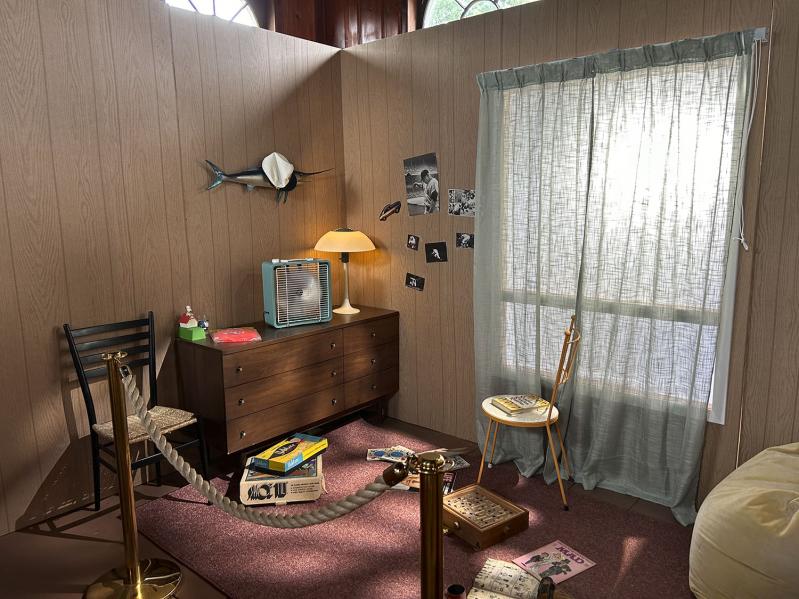More than 60 years ago, a New York City man named Murray Braverman walked into Macy’s Department Store in Herald Square to buy chairs for his waiting room. Instead he came out with a house, four houses actually. With a down payment of $10 each, he secured Leisurama houses for himself and three friends in Montauk.
“He said ‘I have three kids and it would have cost more to send them to summer camp,’ ” said Mia Certic, executive director of the Montauk Historical Society.
Mr. Braverman was the father of one of Ms. Certic’s childhood friends, Michael Braverman, and they spent their summers in those Leisurama houses and on the beaches of Montauk. Now Ms. Certic, who still lives in the Leisurama her family bought, and the historical society have recreated one of those houses, 1960s style included, inside the Carl Fisher House for all to see. Ms. Certic leads tours of this exhibition daily, taking visitors back to the swinging sixties.
The name “Leisurama” was an apt one for the time period. “Think back to the idea of ‘The Jetsons,’ ” Ms. Certic said, “a future where technology frees us from work and gives us time for leisure.” It wasn’t just the houses that were being sold but the idea of leisure. “As for the ‘ama’ part,” she said, “that word play really took off in the fifties and sixties. Think ‘Bowlerama,’ things like that.”
In the dining room area of the Carl Fisher House, across from the exhibit, the historical society has set up a two-sided accordion-style timeline. On one side it breaks down historical highlights of the sixties and seventies and on the other side is a history of the Leisurama that gives context to its creation. The story begins during the Cold War, in 1959, with an American delegation to Moscow, where the Long Island developer Herbert Sadkin presented the “typical American home,” based on one he had built in Commack, to show off the American way of life. He also hired the industrial designer Raymond Loewy and Macy’s to furnish it.
It was a hit during the exhibition in Moscow, and was the setting for the famous “kitchen debate” between Soviet Premier Nikita Khrushchev and then Vice President Richard Nixon. This experience inspired Sadkin and upon his return to America, he reassembled the team, adding the architect Andrew Geller. Together they aimed to create affordable second homes for families, and ended up building them on a parcel of land between the Montauk docks and Culloden Point.
To bring this exhibition to life, Ms. Certic brought together a team of her own, specialists who rewound time right in the Carl Fisher House: the graphic designer Diane Sheridan, the film and television professional Mara Certic, and the cinematographer Marcin Kapron, who did the lighting design and installation. The Robert D.L. Gardiner Foundation and Terry Bienstock of Montauk also generously contributed to bring the exhibition to fruition.
Most of the furniture featured in the exhibition was gifted by the heirs of Florence Donohue, all original from one of the 1965 homes. There is also a chair on loan from Jim Lancaster, a Montauk real estate agent and Leisurama enthusiast, as well as a very special lamp on loan from John D’Agostino, another Montauk real estate agent and Leisurama enthusiast.
“This lamp is my favorite piece,” Ms. Certic said. “It’s an actual Loewy lamp (named after the designer) and it’s amazing it’s survived.” She added that these lamps had a tendency to melt from the heat of lightbulbs because they were made out of plastic.
The exhibition itself is also an homage to how the houses were marketed. For an easier sell, full-scale model homes were set up in various locations for customers to walk through. “They had one at the ‘64-’65 World’s Fair and Roosevelt Field,” Ms. Certic said, “and famously one on the ninth floor of Macy’s. It was a classic story of a woman going to buy a bra and coming home with a house.”
Without giving too much away, a highlight of the exhibition is a little screen on a wall playing home movies from Montauk in the sixties. The film comes by way of Ms. Certic’s childhood friends, the sisters Gunnel and Jane Orndahl. On a little table in front of the wall there are two rotary phones through which, when picked up, one can hear Jane Orndahl, Michael Braverman, and another friend, Jessica James, speaking about what it was like spending their summers in the Leisurama community.
Immersive may be the perfect word to describe this experience. Walking into the model home’s kitchen with sixties tunes playing, the exhibition takes you back to sixties summers on the beaches of Montauk.
The Leisurama exhibition is running until Labor Day at the Carl Fisher House, which is at 44 Foxboro Road. It is open for self-guided tours Thursday through Monday from 12:30 to 4:30 p.m. and until 5:30 on Friday, with guided tours offered at noon.
Tickets cost $15 for adults, $10 for members of the Montauk Historical Society, and $5 for children between the ages of 5 and 12. Guided tours cost $20, or $12 for historical society members, and can be bought through the society’s website.




